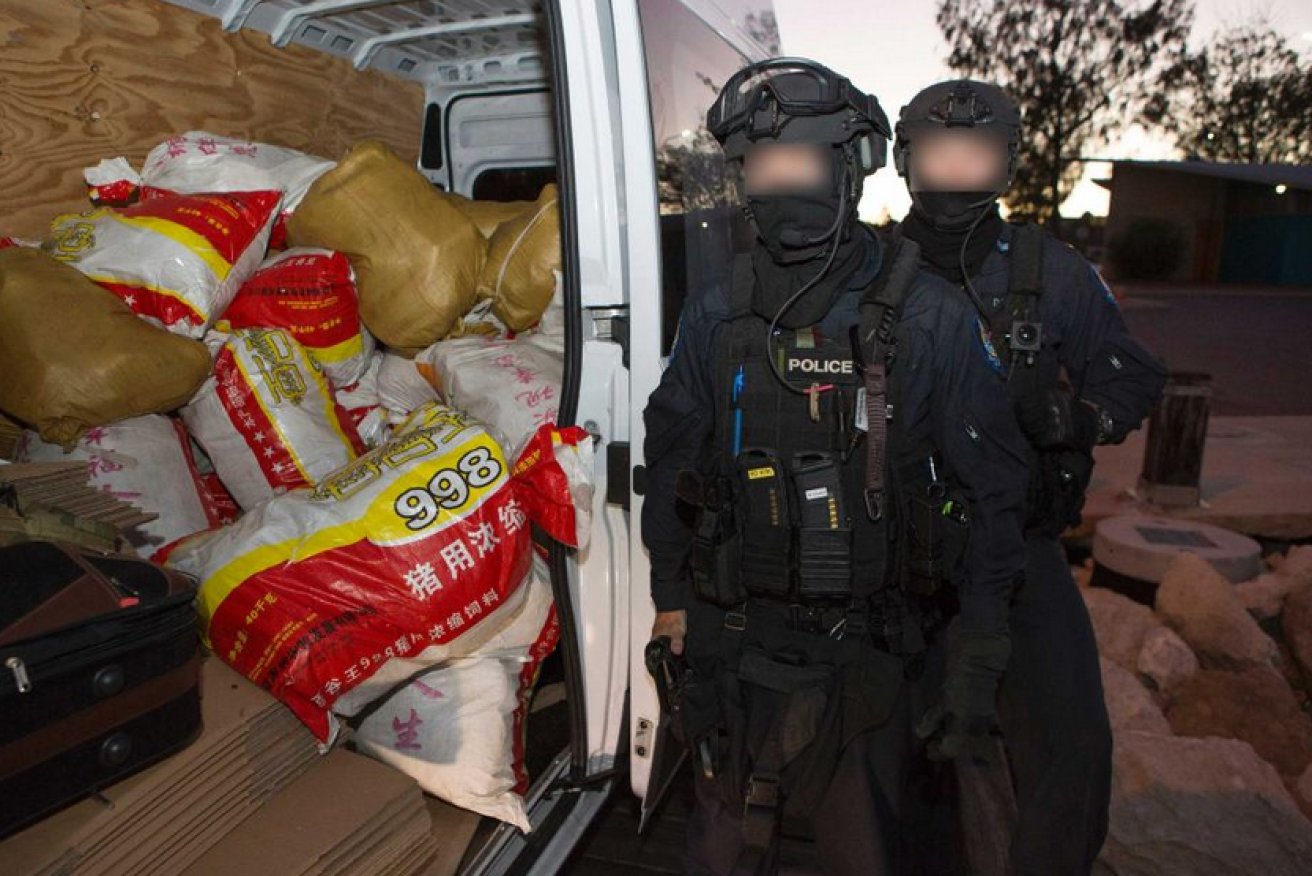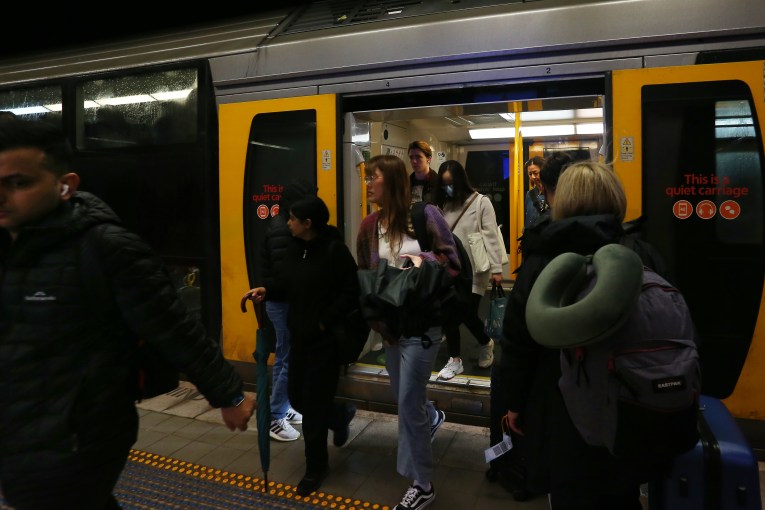The Myanmar ice connection: From pop-up labs to Australia’s streets

Australian Federal Police, faces obscured to protect their identities, guard a van loaded with a tonne of Myanmar-made ice. Photo: AFP
In Myanmar, the more conflict there is, the more drug production you’ll find. And the trade has brought together unlikely friendships.
Last year, Myanmar soldiers drove 700,000 Rohingya from their homes in Rakhine State, often burning their villages to the ground. Now, some of the same soldiers are reportedly working with poverty-stricken refugees trafficking drugs.
The unlikely partnership speaks to the breadth of Myanmar’s drug crisis, with even a monk arrested last year in Rakhine State carrying 400,000 meth pills.
“No walk of life is untouched by the drug problem” says Troels Vester, UNODC Myanmar country director.
Jungle labs to Australia’s streets
Myanmar is the second largest producer of opium in the world, after Afghanistan. It’s also one of the largest producers of methamphetamine and much of it is making its way to Australian streets.
It doesn’t take much to produce “yaba” — small red pills made from meth and caffeine — just a small kitchen and a few chemicals.
Mobile labs can easily pack up and run, which Myanmar authorities say makes it difficult to track down labs.
“Myanmar can’t produce chemicals, but we are situated between China and India which are the biggest producers,” explains Police Colonel Zaw Lin Tun.

The ice epidemic is taking a dreadful toll in Australia. Photo: Getty
Huge quantities of chemicals are being seized around the industrial city of Mandalay in central Myanmar. From this hub, they make their way to conflict areas, according to Mr Vester.
Colonel Zaw Lin Tun estimates the regional meth market is worth $40 billion. While yaba pills are rife in Myanmar, meth is arriving to Australia in crystal form, through parcel post, drug couriers at airports and commercial shipments.
“There’s no one method, but the type is usually high-purity crystal meth, and the source is almost always south-east Asia and recently Myanmar,” says Jeremy Douglas from UNODC Asia Pacific.
Mr Vester says there is no district in Myanmar where police are not seizing methamphetamine.
Refugee camps to drug rings
Over the border in Bangladesh, Rohingya refugees are unable to work legally and many have turned in desperation to life as drug mules, including children.
At least 120 people have been killed and about 7000 arrested by Bangladeshi authorities since May in a crackdown on yaba trafficking that’s drawn comparisons to President Duterte’s “war on drugs” in the Philippines.
In October last year, two Myanmar soldiers were questioned after they were found with nearly 2 million yaba pills in Rakhine State.
“We have seen reports of collusion or working together,” says Mr Douglas, referring to soldiers and the Rohingya trafficking drugs together.
“Transnational organised crime groups are very good at using that chaotic scene, fighting [and conflict], to do their business,” says Mr Vester.
Conflict plays out across Myanmar between ethnic groups and the country’s army. As well as Rakhine State, other northern states are embroiled in turmoil, including Shan and Kachin. The autonomous Wa region is another hot spot, sharing a border with China which allows easy access to meth chemicals.

Driven from their homeland and unable to work legally, the drug trade lured refugees. Photo: AP/Dar Yasin
The drug ring in northern Rakhine State is not new, says Mr Vester, but with the Rohingya conflict it has increased.
Bangladesh and Myanmar border forces seized nearly nine million methamphetamine pills in the first three months of 2018. This reflects both a growing yaba market in Bangladesh and increasing use of the country as a passage to its neighbours.
Malaysia and Australia made their largest ever seizures of methamphetamine each in May and December, with separate seizures of 1.2 tonnes. Profiling revealed the drugs were all produced in Myanmar.
Meth goes up in flames
At the end of June, drugs worth US$183 million went up in flames in Myanmar. It wasn’t a meth lab on fire, instead it was a deliberate annual burning of drugs seized by the government to mark International Day Against Drug Abuse.
The Myanmar government called on its citizens to become informants, tipping off drug cases to a new department in exchange for “special tax incentives”.
“I urge you all to destroy narcotics [which] have engulfed our society, destroying our country’s dignity and the potential of our youth,” said President U Win Myint.
Colonel Zaw Lin Tun also hopes citizens will report trafficking and believes the drug crisis must be at the heart of national peace talks.
“Of course it is fuelling conflict, so drug elimination is our national duty,” he says.
The ‘crazy drug’
But it’s not that simple. Kyaw Lwin was a university student when he first tried yaba — which means “crazy drug” in Thai — and says people don’t understand the scope of the problem.
“I don’t think people realise how big a problem drugs are here. They are just so cheap and everywhere,” the 21-year-old says.

The white powder is heroin, long the staple of Asia’s drug market. Now the methedrine “yaba” pills are the new scourge. Photo: EPA/Barbara Walton
He was at a friend’s house when someone gave him a red pill they said would make him “feel fresh”. But after a month he became addicted and was taking one to three pills every day.
“As a side effect, I felt angry all the time. The main way it really affects you is mentally.”
Kyaw Lwin says families and their community don’t know how to handle people with a methamphetamine problem.
“We need more awareness, not to just arrest them,” he says.
Addicts behind bars
Myanmar’s focus on street supply has seen thousands of addicts put behind bars. Ko Sai Aung Kham is one of them, having served a five-year sentence for drug possession.
In jail, he was more worried about the stigma he’d face when he was released than falling back into addiction.

The number of imprisoned meth users is growing, but use of the drug refuses to decline. Photo: EPA
“We are not welcomed back into society. Discrimination from the community is too intense,” Ko Sai Aung Kham explains.
Awareness is only beginning to spread that drug abuse is a health problem and not all users are criminals.
“The number of drug users is increasing day by day and the health department doesn’t know how to handle the problem,” he says.
After serving his sentence, Ko Sai Aung Kham decided to establish a support network, visiting tea shops with friends to talk to customers about health problems and how to quit drugs.
“Drug users may not want to talk to their family, but they do want to learn more about what support is available and about harm reduction,” he says.
“It’s not much, but you have to start somewhere and just talk to people.”
Follow the money
Countries hammered by the drug problem — including China and Australia — met in Myanmar’s capital Naypyidaw in May to discuss a new strategic plan. But there is no easy fix to the drug crisis without addressing systemic problems in south-east Asia.
“To be candid, it also means addressing the corruption, conditions and vulnerabilities that allow organised crime to keep expanding operations and exploiting the region,” says Mr Douglas.
He says the key to disrupting the supply chain is targeting the laundering of massive amounts of drug money.
Cracking down on street supply has had minimal impacts and Mr Douglas says it can be counterproductive: “Australia and UNODC are trying to get countries to focus efforts on the transnational organised crime groups behind the production and trafficking.”
–ABC








